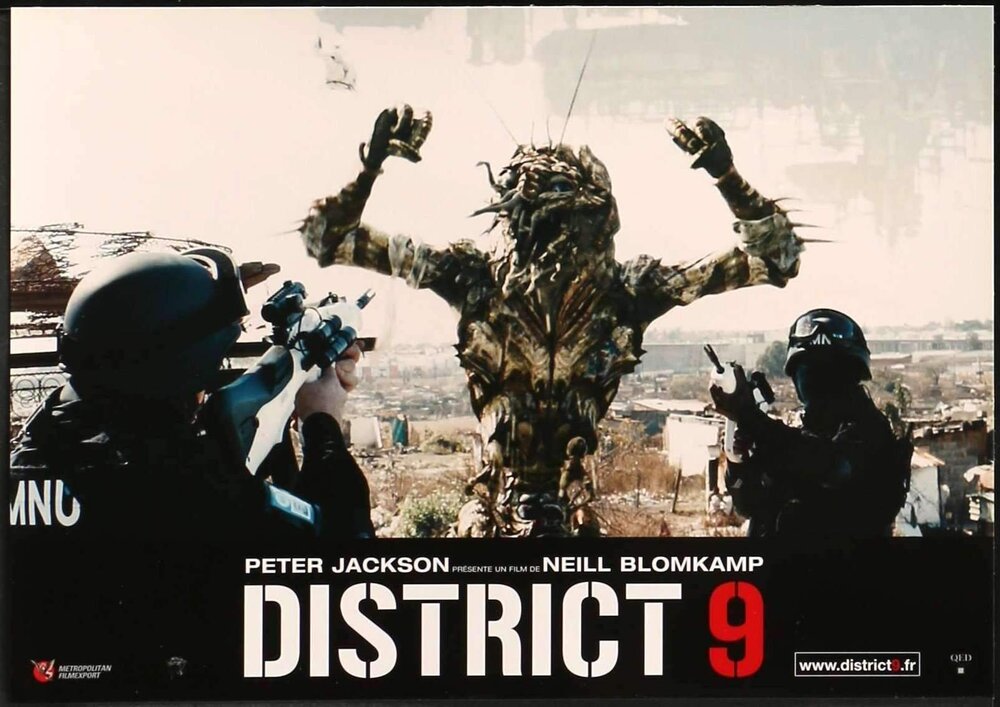
(Image: originalfilmart.com)
The Plague of Exile
By Steven DeGiorgi
Abstract
After analyzing Neill Blomkamp’s District 9 (2009), the setting of the film capitalizes on the post-colonial setting in Johannesburg, South Africa. What we viewed in the film as a representation of South Africa’s past, through an alternative perspective that identified the oppressed African people as aliens, known as the ‘Prawns’. The isolated community of District 9 represents oppressed living conditions for the millions of people negatively affected during the Apartheid rule (1950-94) (Weaver). For half a century, the South African people had faced dehumanization and discrimination by xenophobic Europeans. The caricature of the European colony was portrayed as the private military, MNU. They followed a typical method of a dystopian society, where power was diverted from the people to the hands of the government. For example, Michel Foucault scrutinized a government that surveyed, exiled, and regulated the populations’ life with militarized zoning (Foucault). They were able to isolate and achieve containment of Power, and control of the population within. My thesis focuses on the utilization of various tools of power that provokes the instincts of survival to control and oppress societies.
Film Analysis
District 9 was filmed as a documentary that resembles a historic event in Johannesburg’s history. Through a post-colonial and post-modern perspective, we see a collage of racial tension, xenophobia and authoritarian control that is a representation of the destructive power of apartheid law. Cinéma verité (which means cinema truth), replicates the realism of the experience with simple equipment and cinematic filming techniques (Conway). This intentional and appropriate style of film coalesces with the cynical and corrupt practices in dystopian societies. The influential power of the media is utilized to assist the Multi-National United (MNU) in achieving its goals. The MNU sponsored documentary is manipulative and subjective in directing discriminatory anger, fear and hatred towards the Prawns (figure 1). Scenes in the documentary demonstrate the credibility of MNU as a reliable and knowledgeable resource. Interviews with university professors, scientists, officials, and alien specialists, tells their speculations on the information they analyzed. These interviews also display a backdrop of well ventilated and air-conditioned offices that are associated with the higher class. Their ‘credible’ speculations presented itself as subjective and bias, where the Prawns were never represented fairly and accurately. Other scenes intentionally showcase the destructive nature of the Prawns. Derailed trains, burning stores, and frightened citizens set the landscape as a demonstration to the viewers (figure 2). These clips testify to what the interviewees had explained. The videos speak a reality about the aliens that support the preconceived notion that they are hostile, making it hard to believe that the Prawns can be reasoned with.
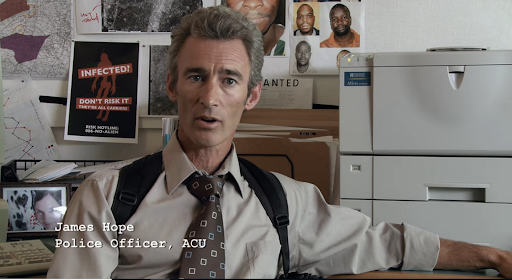
Fig 1 (left): Interview promoting discrimination

Fig. 2 (right): Johannesburg’s citizens reactions and public signs
Blomkamp paid much attention to the reality of racial conflicts and are represented by the lore of the film. Intergalactic cannibalism, prostitution, idleness, homelessness and even the unintelligible ‘clicking’ language of the Prawns are all intentional in portraying the identity of the oppressed African community. This strong connection that Blomkamp insists on, introduces the human quality of a sensitive socio conflict of disposition (figure 3). The common factor that separates a community is the fear of the unknown. Edward Said’s study on Orientalism is relatable to this perception of the unknown. The Orient, pertaining mainly to middle easterners, Indians, and northern Africans, has been addressed to the world as barbaric, perverse and unintelligent. Through books, art and stories, they share the indirect experiences with the orients that creates a disconnection from reality (Said). In District 9, the documentary of propaganda and signage of xenophobia are the mediae that encouraged the response of segregation. The majority of the citizens were unable to interact with the aliens due to the five-mile radius of District 9 (figure 6). A fortified barrier contained and separated the Prawns from the city. Citizens only understood the situation only through a skewed perspective that conveyed a conclusive and superficial narrative that is convincing that the prawns are the common enemy. This method has made it possible for MNU to carry out classified programs in research in integrating and selling alien technology. The lesser social and foreign populace are susceptible targets for scapegoating where a government can divert attention away from their evil and political schemes. To assist in understanding the human factor and the importance of containment and information, this case study of a dystopian society is applicable to my thesis and beyond the cinematic universe.
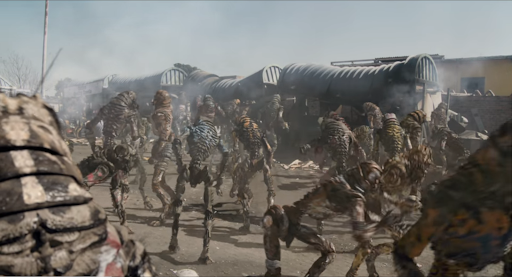
Fig. 3: District 9 alien community. A resemblance to the shanty-town culture during the apartheid.

Fig. 4: (1948) The beginning of Apartheid. Lost and idling citizens segregated into rural communities
Societal case study
Michel Foucault is a social theorist whose primary focus is on the relationship between power and knowledge. His study on the systematic methods of the authoritarian ruling is critical in understanding the process and effect segregation has in District 9. In Discipline & Punish: The Birth of the Prison, Foucault scrutinized a report of a cynical government that forced society to obey and conform to their authority. Transformed from a town crippled by a plague of leprosy into oppressed and disciplined working society, the government had used a typical method to achieve their political goal. Surveillance and discipline are the elements Foucault identified from the report and is applicable to the methodology we see in District 9.
The town was told ambiguously, only noting that the event occurred during the seventeenth century. The town was seized by their government through a hired syndicate, who’s purpose would have seemed to be to eradicate the disease, but instead, dictated their way of life. Their political dream of achieving a disciplined and loyal workforce for financial and political gain became more apparent as implications of prohibitions and segregation disrupted their freedom. Strict spatial partitions divided the town into four quadrants. People and resources became stagnant under the observation of the syndicate. As Foucault puts it, it became “a segmented, immobile and frozen space”. Any criminal behavior would be within sight of an observation post or sentinel, where any ’disorderly’ movement would be severely punished by being beaten, exiled or murdered. All members of the syndicate were responsible for reporting all offenses and personal identification within the town. Information was relayed through a hierarchy of intendants, and to a central intelligence where executive decisions were generally made. The involvement of the government and contagious disease brought death to every corner of the town. “The plague is met by order; its function is to sort out every possible confusion: that of the disease is transmitted when bodies are mixed together; that of evil, which is increased when fear and death overcome prohibition.” (Foucault). Survival has become the way of life as more people were exiled and died to the leprosy quarantine. Consequently, the town grew more separated as the population generalized itself into two identities: normal and abnormal. To be abnormal is to cause a commotion or be infected. To survive, many would protect themselves from other people by fight or flight. So then fear is the government’s fuel that encouraged the people to submit themselves or endure death.
Application to Architecture in District 9
Just as the syndicate used quarantine as a tactic to control the people, MNU’s District 9 containment served a similar purpose that made their goals attainable. District 9 functioned as a fortified institution camp that centralized an attraction for racial hatred and terror. Conclusively, It would be undesirable to interact or affiliate with the “abnormal” aliens beyond the border. Both the MNU and the syndicate benefited by the incarceration of aliens and exiled alike. Although they certainly differ in certain areas in their narratives, we accumulate an understanding of the methods in the dystopian genre.
A strict demarcation zone preserved peace between the communities of the two species. Away and out of sight, the Prawns were left in isolation to develop their alien colony. Their weapons, creatures, and culture were brought to the surface and were classified as hazardous and unusual to humans. The unknown lifestyle in District 9 had been identified as a disease that can spread and affect the surrounding area and possibly the entire world. This is more apparent when Wikus van de Merwe (Sharlto Copley), the main character and representative of MNU, unexpectedly morphed into a Prawn by an alien substance. His genetics gradually mutated, which gave him the appearance and abilities of a Prawn. From this moment, he is no longer identified as human even though he was still mostly human. MNU saw him as a valuable asset for experimentation and exploitation because of his new ability to wield a variety of extremely powerful alien weapons. Wilkus desperately and violently escaped the secured MNU facility with his new ability. However, we see that his ability is a double-edged sword, in that he became socially separated. He had been rejected and dreaded by his friends, family and his city. He was avoided like the plague as the news announced him as a violent criminal. With nowhere to hide, he found refuge in District 9.
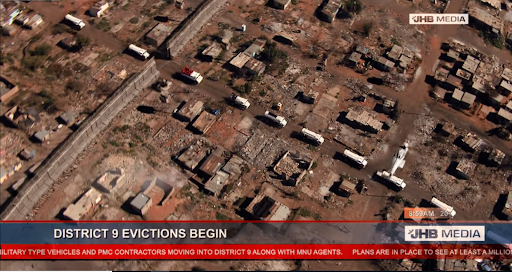
Fig. 5: The fortified border gate of District 9. MNU initiating the repositioning of the Prawns.
The binary separation of humans vs aliens did not allow a grey area where Wilkes, a hybrid between the two, can have an identity in both. This was not confirmed in the film, but based on my speculations that; in realizing the possibility of transformation into alien can occur, the reaction must have been an increase of xenophobia and separation within the community. The possible uncertainty that turning into an alien is, an infectious disease, would change the relationship between people, and with the aliens, possibly escalating into war. The human instincts of survival like avoidance, discernment, and retaliation, contribute to the realism in these narratives. We do not need to be a scholar to empathize with the populace, because of our mutual and inherent rational to survive that justifies their decisions. When provoked by law and prohibition, we too may act in a similar response.
The significance that architecture had in these environments is dependent on the purpose of a situation. The buildings, barriers, slums, townhouses and general infrastructure are all fixated by the needs of the user. To achieve survival or political power, the individual will do and make what they can with architecture. Whether the motive was good or bad, the space that is defined by architecture is consequential, becoming apart of society as a physical limitation; cause and effect. Architecture is the tool that supplements the need and desires of people. The border of District 9 is created like any other containment areas. They make the division between normal and abnormal. Within their walls, they mark the territory for the forsaken, forgotten, unknown and unrelated to the rest of society (Figure 5). The walls shaped the lives of its inhabitants, restricting them to powerlessness.
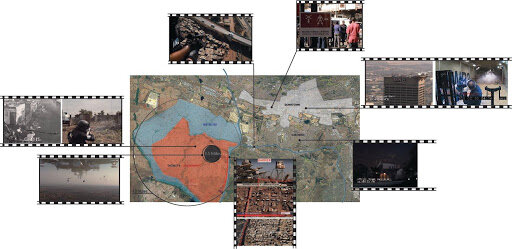
Fig. 6: Diagram of the urban context in District 9
Citations
Daniel Conway (2017) Framing a new reality: documenting genocide in District 9, International Journal of Philosophy and Theology, 78:4-5, 444-455, DOI: 10.1080/21692327.2017.1338158
Jackson, Peter, Neill Blomkamp, Terri Tatchell, Carolynne Cunningham, Bill Block, Ken Kamins, Sharlto Copley, et al. 2009. District 9.
Rieder, John. “Race and Revenge Fantasies in "Avatar," "District 9" and "Inglourious Basterds".” Science Fiction Film and Television 4, no. 1 (2011): 41–56. https://ift.tt/2qRiv1c.
Said, Edward W. Orientalism. First edition. New York: Pantheon Books, 1978
Weaver-Hightower, Rebecca, and Hulme, Peter. Postcolonial Film : History, Empire, Resistance. New York ; London: Routledge, Taylor & Francis Group, 2014

from REVIEW BLOG - Every Movie Has a Lesson https://ift.tt/2LQQY7a







No comments:
Post a Comment